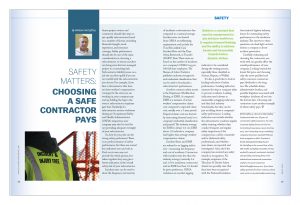Safety Matters: Choosing A Safe Contractor Pays
Smart project owners and contractors should take steps to pre-qualify subcontractors based on a number of factors, including financial strength, work experience, and insurance coverage. Safety performance should also be one of the main considerations in choosing a subcontractor. A serious accident can bring even the best-managed project to a screeching halt.
Subcontractor liability issues on a job site can flow uphill if you are not careful with the subcontractors you choose. For example, if you hire a subcontractor that does not have workers’ compensation coverage for the state you are working in, your company may end up holding the bag in the event a subcontractor employee gets hurt. Similarly, if a subcontractor receives violations during an Occupational Safety and Health Administration (OSHA) inspection, your company may also be cited for not providing adequate oversight of your subcontractor.
So, how do you pick out the strong safety performers? There is no perfect measure of safety performance, but there are several key indicators you can look at. Each on its own may not provide the whole picture, but taken together they may give a better indication of the overall safety risk of your subcontractor.
Incident rates can be used to show the frequency and severity of incidents a subcontractor has compared to a national average. Incident rates are derived from OSHA recordkeeping requirements and include the Total Recordable Case Incident Rate and the Days Away, Restricted, or Transfer (DART) Rate. These rates are based on the number of incidents on a company’s OSHA Log per 100 full time employees. The Bureau of Labor Statistics publishes industry averages for each industrial classification that can be used to benchmark a subcontractor’s performance.
Another common safety metric is the Experience Modification Rating, or EMR. A company’s EMR is a measure of actual workers’ compensation claims cost compared to expected claim cost, usually over a 3-year period. Expected claim costs are derived by state rating bureaus based on a company’s industrial classification and payroll. The industry average for EMR is always 1.0. An EMR above 1.0 indicates a company had higher than average workers’ compensation claims.
Incident Rates and EMR are referred to as lagging indicators—measuring the frequency and cost of accidents. Contractors with incident rates less than the industry average (currently 2.6 and 1.8 for insulation contractors) and an EMR less than 1.0 should be given preference. OSHA violations are another lagging indicator to be considered during the vetting process, especially those classified as Serious, Repeat, or Willful.
It’s also a good idea to look at leading indicators of safety performance. Leading indicators measure the steps a company takes to prevent accidents. Leading indicators aren’t always as measurable as lagging indicators, and they lack industry benchmarks, but they can be just as telling about a company’s safety performance. Leading indicators can include whether the subcontractor conducts regular safety training, whether they conduct frequent and regular safety inspections, if the company has a safety committee and/or dedicated safety professionals, and whether near misses are reported and investigated. Also, ask if the company has received any safety awards or recognition. For example, recipients of the Theodore H. Brodie Safety Award can proudly state that they have been recognized with the National Insulation Association’s highest industry honor for outstanding safety performance in the insulation industry. The answers to these questions can shed light on how serious a company is about accident prevention.
Carefully evaluating and choosing the contractors you work with can greatly affect the overall performance of your company. Looking beyond the lowest bid price and choosing only the most qualified and safety conscious contractors pays dividends in the long run. The schedule delays, administrative burden, and possible litigation associated with workplace incidents all eat into the bottom line. Choosing safe contractors is yet another example of where safety pays.
Copyright Statement
This article was published in the June 2018 issue of Insulation Outlook magazine. Copyright © 2018 National Insulation Association. All rights reserved. The contents of this website and Insulation Outlook magazine may not be reproduced in any means, in whole or in part, without the prior written permission of the publisher and NIA. Any unauthorized duplication is strictly prohibited and would violate NIA’s copyright and may violate other copyright agreements that NIA has with authors and partners. Contact publisher@insulation.org to reprint or reproduce this content.

